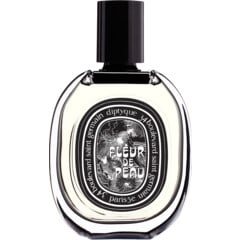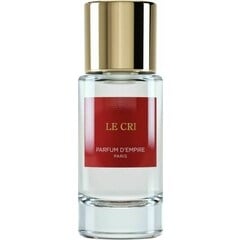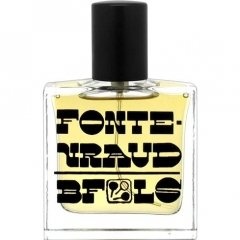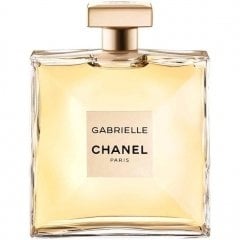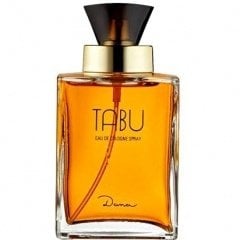
jtd
Reviews
Filter & sort
fleur de peau
Dyptique’s Fleur de Pear was released about a year after Le Cri de la Lumière and is also based on an ambrette accord. If I had to characterize the difference between the two, Le Cri stems from the overlapping of its notes and accords and Fleur de Pear is build from a sequence of consecutive musk accords that appear one after the other. Convergence. Divergence. Two different approaches to ostensibly similar accords.
Fleur de Peau moves very differently than Le Cri. Wearing it is like strolling from room to room in a large house. Each musk is joined to the next in a chain. The top note is a papery iris. Then a starchy musk à la Mugler Cologne. Then a grainy pear, then shoe polish, then waxy skin. No accord goes away entirely, but they don’t merge. They just reappear periodically. This olfactory junket is captivating in that it’s so meticulous and methodical. It’s not just the aromas that oscillate, it’s the tones. The iris is cry and crinkly, the rose is sheer, the pear is grainy, the skin note is fatty and waxy. The accords maintain their edges and don’t bleed into each other. They simply rotate.
Diptyque’s ambrette is more animalic than Perfume d’Empire’s and it’s very human. The Diptyque ventures much further into the sweaty-skin facet of ambrette, which can make the perfume seem a bit odd as it moves from sweat to laundry soap to floral bouquet. If you tune in closely to the perfumes fluctuations, though, it’s compelling.
The specificity of the composition creates an interesting opportunity for perfume critics. The fluctuation of the perfume, its progression through distinct olfactory territories creates the opportunity to consider composition without referring to formula per se. It can be described in terms of its qualities and can be analyzed based on its dynamics. Any perfume can be viewed this way, but Fleur de Peau lends itself particularly well to this approach.
from scenthurdle.com
Fleur de Peau moves very differently than Le Cri. Wearing it is like strolling from room to room in a large house. Each musk is joined to the next in a chain. The top note is a papery iris. Then a starchy musk à la Mugler Cologne. Then a grainy pear, then shoe polish, then waxy skin. No accord goes away entirely, but they don’t merge. They just reappear periodically. This olfactory junket is captivating in that it’s so meticulous and methodical. It’s not just the aromas that oscillate, it’s the tones. The iris is cry and crinkly, the rose is sheer, the pear is grainy, the skin note is fatty and waxy. The accords maintain their edges and don’t bleed into each other. They simply rotate.
Diptyque’s ambrette is more animalic than Perfume d’Empire’s and it’s very human. The Diptyque ventures much further into the sweaty-skin facet of ambrette, which can make the perfume seem a bit odd as it moves from sweat to laundry soap to floral bouquet. If you tune in closely to the perfumes fluctuations, though, it’s compelling.
The specificity of the composition creates an interesting opportunity for perfume critics. The fluctuation of the perfume, its progression through distinct olfactory territories creates the opportunity to consider composition without referring to formula per se. It can be described in terms of its qualities and can be analyzed based on its dynamics. Any perfume can be viewed this way, but Fleur de Peau lends itself particularly well to this approach.
from scenthurdle.com
le cri
From the first sniff of Cri, you’re drawn directly to the center of the perfume. Perfumer Marc-Antoine Corticchiato even factors in the volitility of the alcohol burning off and uses it to segue into a lustrous accord with the olfactory dynamic of an eau de vie. The topnote is like the scent of Poire Williams brandy or Slivovitz, where the fruit is pressed so far into the alcohol that it is reduced to essentials. It’s neither juicy nor sweet and has an incisive slant. My note from first sampling Cri de la Limière reads, “Super fruity but dry as fuck.” Not the loftiest of insights, but apt. The Poire Williams note is the perfect backdrop for a sleek iris note. Woody, rooty, cool to the touch. Matching iris to the desiccated fruit brings out the vegetal nature of ambrette.
Cri de la Lumière is a closely tailored perfume that holds to a tight dynamic range. Rather than broaden the composition the musk accord focuses it, though the perfume sidesteps the strictness that a minimalist approach can impart. The rosy, fruity facets of ambrette are balanced by a plastic quality that gives a deliberate synthiness to the perfume. The fruit appears embedded in clear lucite and the slightly peony-like berry/rose gives a transparent pink sheen to the perfume. The effect is perfectly calibrated and though subtle, is durable. The fruit gives Cri de la Lumière a stained-glass effect and despite the specificity of the fruit notes, the perfume reads as fairly abstract.
The perfume’s woodier side reveals itself periodically like a bit of slip showing. Once I spotted it, I couldn’t stop looking for it to reappear. This sort of diversion is a good example of how Corticchiato’s perfumes engage the wearer. Whether in a forceful perfume like Tabac Tabou or a more watercolor one like Osmanthus Interdite his perfumes reward your attention with engaging olfactory shapes and transitions. The perfume plays subtly with the animalism found in musk ambrette. (Musk ambrette smells like a sweaty, imaginary fruit.) Of the various dimensions of the material, the animalic feature is among the most durable. Corticchiato doesn’t hide the material’s ‘skin’ side but he does nest it fairly deep into the perfume, where is is a quiet foil to the plastic, acrylic details.
from scenthurdle.com
Cri de la Lumière is a closely tailored perfume that holds to a tight dynamic range. Rather than broaden the composition the musk accord focuses it, though the perfume sidesteps the strictness that a minimalist approach can impart. The rosy, fruity facets of ambrette are balanced by a plastic quality that gives a deliberate synthiness to the perfume. The fruit appears embedded in clear lucite and the slightly peony-like berry/rose gives a transparent pink sheen to the perfume. The effect is perfectly calibrated and though subtle, is durable. The fruit gives Cri de la Lumière a stained-glass effect and despite the specificity of the fruit notes, the perfume reads as fairly abstract.
The perfume’s woodier side reveals itself periodically like a bit of slip showing. Once I spotted it, I couldn’t stop looking for it to reappear. This sort of diversion is a good example of how Corticchiato’s perfumes engage the wearer. Whether in a forceful perfume like Tabac Tabou or a more watercolor one like Osmanthus Interdite his perfumes reward your attention with engaging olfactory shapes and transitions. The perfume plays subtly with the animalism found in musk ambrette. (Musk ambrette smells like a sweaty, imaginary fruit.) Of the various dimensions of the material, the animalic feature is among the most durable. Corticchiato doesn’t hide the material’s ‘skin’ side but he does nest it fairly deep into the perfume, where is is a quiet foil to the plastic, acrylic details.
from scenthurdle.com
fontevraud
Fazzolari calls his new perfume, “a celebration of the ancient and the contemporary” and names it Fontevraud, after a serially repurposed abbey in France. It is produced in a very limited run (50 bottles) in celebration of Los Angeles’s famed perfume retailer LuckyScent/ScentBar’s 15th anniversay. Combining a chypre with a fruity floral is a logical old/new combination, but as with Fontevraud Abbey’s cortège from monestery to prison to UNESCO World Heritage Site, Fazzolari’s Fontevraud is neither expected nor obvious. I’ll admit I had reservations when I saw the list of notes, which includes guava, rose and pear. Visions of Sophia Grosjman’s Calyx for Prescriptives came to mind. A gorgeous perfume, but perhaps the most hyperbolic fruity chypre ever made.
A chypre is not a new undertaking for Fazzolari, who previously nailed the genre with the voluptous Au Delà/Narcisse and the gleaming Seyrig, but true to his claim Fazzolari devises something new. Most attempts to resuscitate the genre try to fill in the hole left after oakmoss and all the other noxious materials were dug out. They shovel in patchouli, laundry musks and PR bullshit about how authentic the perfume is. But they’re counterfeit and they smell forged. The effort of wearing them without feeling like a fraud is too much for me.
Fazzolari punks us all by creating one of the mossiest perfume in recent history that doesn’t actually smell like a traditional chypre. Fontevraud uses the chypre’s compositional configuration as a starting place to build a perfume with a texture different than either the time-honored or spurious versions. It focuses on the material’s resinous facets more than its inky and smokey qualities and lends itself to darker hues like dry fruit and spicy balsams.
Rose chypres were known for their brassiness. The outspokenness of the flower often gave the perfumes hulking presences. Rose is seeded throughout Fontevraud, from top to base and from resinousness to fruitiness, but I feel as if I see it through a mirror. Visible, apparent but just out of reach no matter how close. Rose lines the whole perfume and carries a big stick but doesn’t push its way to the front. It’s a great way to tame a big note without actually declawing it.
Fruit is another common chypre component but guava and pear are unorthodox picks. Fazzolari plays both fruits against type. He avoids the predictable tropical clichés of guava by giving it a dark edge. It’s as if he compresses the fruit’s distinctive redolence into a compact shape and, while it smells like guava, it smells dark, almost bitter. On the tree or in the kitchen pear’s distinctive sweet scent really only comes forward when the fruit is ripe. Before that it smells more woody than fruity. Fontevraud plays on the woody facet of pear by emphasizing the sharp, almost vinegary taste of the skin of the fruit. Fontevraud’s pear appears within the first minute that the perfume is applied but the reveal is somewhat startling. A mineralic opening segues into a mushroom note (Fazzolari says it’s a function of opoponax) which in turn becomes a grainy pear note. It’s a surprising transition that took me a few wearings to wrap my head around but now I give myself a minute or so after applying Fontevraud just to get taken for the ride. It’s a blast.
The fruit tones that Fazzolari comes up with are unexpected but appealing and he has played fruit against type before. Monserrat uses a peach/grapefruit/osmanthus accord to create one of the more sophisticated fruity-florals you’ll find. Unsettled‘s smoky, buttery pineapple manages to be sultry without relying on the simple olfactory language of pineapple=tropical=exotic. Fazzolari calls Fontevraud bright but I disagree. By turning such uninhibited fruits into introverts and creating a reticent rose he designs a stylishly dark perfume that works for the same reason a little black dress or a tuxedo works. It’s impeccable and has a sexy silhouette.
from scenthurdle.com
A chypre is not a new undertaking for Fazzolari, who previously nailed the genre with the voluptous Au Delà/Narcisse and the gleaming Seyrig, but true to his claim Fazzolari devises something new. Most attempts to resuscitate the genre try to fill in the hole left after oakmoss and all the other noxious materials were dug out. They shovel in patchouli, laundry musks and PR bullshit about how authentic the perfume is. But they’re counterfeit and they smell forged. The effort of wearing them without feeling like a fraud is too much for me.
Fazzolari punks us all by creating one of the mossiest perfume in recent history that doesn’t actually smell like a traditional chypre. Fontevraud uses the chypre’s compositional configuration as a starting place to build a perfume with a texture different than either the time-honored or spurious versions. It focuses on the material’s resinous facets more than its inky and smokey qualities and lends itself to darker hues like dry fruit and spicy balsams.
Rose chypres were known for their brassiness. The outspokenness of the flower often gave the perfumes hulking presences. Rose is seeded throughout Fontevraud, from top to base and from resinousness to fruitiness, but I feel as if I see it through a mirror. Visible, apparent but just out of reach no matter how close. Rose lines the whole perfume and carries a big stick but doesn’t push its way to the front. It’s a great way to tame a big note without actually declawing it.
Fruit is another common chypre component but guava and pear are unorthodox picks. Fazzolari plays both fruits against type. He avoids the predictable tropical clichés of guava by giving it a dark edge. It’s as if he compresses the fruit’s distinctive redolence into a compact shape and, while it smells like guava, it smells dark, almost bitter. On the tree or in the kitchen pear’s distinctive sweet scent really only comes forward when the fruit is ripe. Before that it smells more woody than fruity. Fontevraud plays on the woody facet of pear by emphasizing the sharp, almost vinegary taste of the skin of the fruit. Fontevraud’s pear appears within the first minute that the perfume is applied but the reveal is somewhat startling. A mineralic opening segues into a mushroom note (Fazzolari says it’s a function of opoponax) which in turn becomes a grainy pear note. It’s a surprising transition that took me a few wearings to wrap my head around but now I give myself a minute or so after applying Fontevraud just to get taken for the ride. It’s a blast.
The fruit tones that Fazzolari comes up with are unexpected but appealing and he has played fruit against type before. Monserrat uses a peach/grapefruit/osmanthus accord to create one of the more sophisticated fruity-florals you’ll find. Unsettled‘s smoky, buttery pineapple manages to be sultry without relying on the simple olfactory language of pineapple=tropical=exotic. Fazzolari calls Fontevraud bright but I disagree. By turning such uninhibited fruits into introverts and creating a reticent rose he designs a stylishly dark perfume that works for the same reason a little black dress or a tuxedo works. It’s impeccable and has a sexy silhouette.
from scenthurdle.com
What would Gabrielle think?
Chanel says Gabrielle is composed around four classic white flowers: tuberose, orange blossom, ylang ylang and jasmine. They call it, "the perfect white flower." Olivier Polge has called Gabrielle "abstract", an apparent allusion to Chanel's monumental abstract floral, no 5. Abstraction implies veering away from duplicating a given scent and instead reimagining it. Gabrielle is abstract in that it doesn't smell like any of these four flowers per se. In fact it doesn't smell appreciably botanical. Despite the press release talking points describing the perfume's flower as "imaginary" and "perfect", Gabrielle is less an ideal flower than the mean average of a set of 'floral' notes.
Gabrielle is linear for the most part but it has an identifiable drydown. The perfume grows less specific as time passes, though not inadvertently. The drydown seems intentionally indistinct, recreating the risk-averse, bleary musky/woody finish found in many mainstream perfumes geared toward the young female perfume buyer. To its credit, though Gabrielle is a fruity floral it's neither gourmand nor particularly sweet. A mildly acerbic twist runs through the perfume's duration, cropping any nascent sweetness.
Gabrielle hits its marks and doesn't flub its lines but it doesn't inspire. A noncommittal floral mix leading to a fairly anonymous drydown gives Gabrielle a shapelessness that undercuts Polge's efforts to create an ideal white flower. The composition seems specifically calibrated to create soft-focus haze and a dull shine. It's a ho-hum vision of femininity from the house that produced challenging and powerful feminine perfumes like 19, Cristalle and Coco. I don't doubt the expertise and technical proficiency involved in creating a perfume like Gabrielle. It performs precisely as intended and accomplishes its design goals but it reads as a collection of non-negatives. It's attractive in that it's not ugly. It's appealing in that it's not offensive. Again, this strategy seems deliberate. The most flankable perfumes tend to be those that don't commit too strongly to any olfactory characteristics and I imagine it won't be too long until Gabrielle Eau Fraiche, Gabrielle Eau Tendre and Gabrielle Edition Blanche hit the shelves.
(from scenthurdle.com)
Gabrielle is linear for the most part but it has an identifiable drydown. The perfume grows less specific as time passes, though not inadvertently. The drydown seems intentionally indistinct, recreating the risk-averse, bleary musky/woody finish found in many mainstream perfumes geared toward the young female perfume buyer. To its credit, though Gabrielle is a fruity floral it's neither gourmand nor particularly sweet. A mildly acerbic twist runs through the perfume's duration, cropping any nascent sweetness.
Gabrielle hits its marks and doesn't flub its lines but it doesn't inspire. A noncommittal floral mix leading to a fairly anonymous drydown gives Gabrielle a shapelessness that undercuts Polge's efforts to create an ideal white flower. The composition seems specifically calibrated to create soft-focus haze and a dull shine. It's a ho-hum vision of femininity from the house that produced challenging and powerful feminine perfumes like 19, Cristalle and Coco. I don't doubt the expertise and technical proficiency involved in creating a perfume like Gabrielle. It performs precisely as intended and accomplishes its design goals but it reads as a collection of non-negatives. It's attractive in that it's not ugly. It's appealing in that it's not offensive. Again, this strategy seems deliberate. The most flankable perfumes tend to be those that don't commit too strongly to any olfactory characteristics and I imagine it won't be too long until Gabrielle Eau Fraiche, Gabrielle Eau Tendre and Gabrielle Edition Blanche hit the shelves.
(from scenthurdle.com)
1 Comment
old school
I had an ah-ha moment when I tried vintage Tabu for the first time. Suddenly Youth Dew, Opium and Coco made perfect sense---they were descendants of Tabu. Perfumer Jean Carles approach seems based on the premise that if the oriental genre is built from forceful materials and ferocious tones, why disguise it with tassels and trim? Why try to tame it?
Tabu backs up its vaguely threatening name with a strapping, seductive fragrance. It's an intimidating perfumes. The combination of aggressive, spiced florals and powdered leather is just one example of the hard/soft conflict seeded throughout Tabu. (Spoiler alert: the hard edge always wins.) Tabu investigates olfactory extremes without dicking around with the comfortable center. Vanillic amber oriental perfumes often dive straight for the soft middle ground and wind up a bit eye-glazey. The trap for the perfumer is emphasizing coziness at the expense of spine and coming up with olfactory comfort food.
Tabu’s dense powdery opening is in fact sweet but it’s a red herring. As the sweetness of the topnote settles, the acerbic edge of the spiced resin accord comes forward to create a fascinating counterbalance. The powder lasts well into the long-arc heartnotes and the way that it’s cantilevered off the bitter base of resins focusses attention more on texture than aroma. The cinnamon-clove spices have a similarly tricky balancing act. They alternate between hot and cold without ever dwindling to lukewarm. Carles seems willing to concede the aesthetic middle ground, finding more value at the ends of the spectrum. Tabu is technically an oriental but had as much in common with the big tobacco and leather perfumes of the 20s and 30s as it did with the recumbent Shalimar. No fear of lack of spine here.
Jacques Guerlain’s Shalimar is considered the superlative oriental perfume, and for valid reasons. It has superior form and elaborate, sophisticated style. It also has a larger-than-life Auntie Mame quality. Next to Shalimar's layered, accessorized style, Tabu cames off as starched and corseted. Carles’ style was less opulent than Guerlain’s but not a bit less complex. Carles differed from Guerlain in that he found that the richness of the oriental was not in the drape but in the tailoring.
(from scenthurdle.com)
Tabu backs up its vaguely threatening name with a strapping, seductive fragrance. It's an intimidating perfumes. The combination of aggressive, spiced florals and powdered leather is just one example of the hard/soft conflict seeded throughout Tabu. (Spoiler alert: the hard edge always wins.) Tabu investigates olfactory extremes without dicking around with the comfortable center. Vanillic amber oriental perfumes often dive straight for the soft middle ground and wind up a bit eye-glazey. The trap for the perfumer is emphasizing coziness at the expense of spine and coming up with olfactory comfort food.
Tabu’s dense powdery opening is in fact sweet but it’s a red herring. As the sweetness of the topnote settles, the acerbic edge of the spiced resin accord comes forward to create a fascinating counterbalance. The powder lasts well into the long-arc heartnotes and the way that it’s cantilevered off the bitter base of resins focusses attention more on texture than aroma. The cinnamon-clove spices have a similarly tricky balancing act. They alternate between hot and cold without ever dwindling to lukewarm. Carles seems willing to concede the aesthetic middle ground, finding more value at the ends of the spectrum. Tabu is technically an oriental but had as much in common with the big tobacco and leather perfumes of the 20s and 30s as it did with the recumbent Shalimar. No fear of lack of spine here.
Jacques Guerlain’s Shalimar is considered the superlative oriental perfume, and for valid reasons. It has superior form and elaborate, sophisticated style. It also has a larger-than-life Auntie Mame quality. Next to Shalimar's layered, accessorized style, Tabu cames off as starched and corseted. Carles’ style was less opulent than Guerlain’s but not a bit less complex. Carles differed from Guerlain in that he found that the richness of the oriental was not in the drape but in the tailoring.
(from scenthurdle.com)

 jtd
jtd